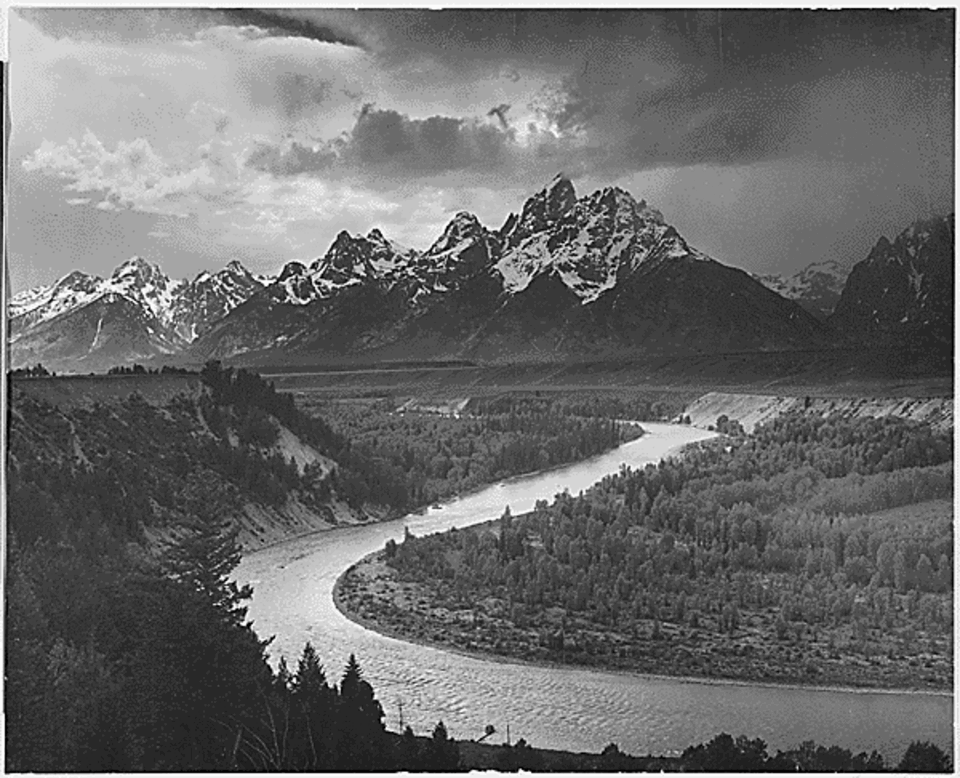
Ansel Adams was an important and iconic landscape photographer based in California.
He used his work to help increase the acceptance of photography by helping create the curatorial department of photography as an art, at the museum of modern art in New York. He also helped establish the San Francisco art institute which had the first ever department that taught photography.
He started off his career as a pictorialist but transitioned into pure/straight photography.
Most of Ansel Adams photos are based in the Yosemite National Park California, which is home to the Sierra Nevada Mountain range. His love for the National park and nature started in 1916 when Ansel Adams was a child and visited the Sierra Nevada on a family vacation. After this initial visit he started visiting the mountains annually and spent a great amount of his life there.
When Ansel was 17 he took on a Job as a custodian for the Sierra club’s headquarters in the national park. Eight years later in 1927, Ansel’s passion for photography grew as well as prescience in the Sierra Club. He started going on outings with the club and quickly became the club’s official photographer and in 1930 became the assistant manager for the club’s outings.
Ansel Adams even said his life was “colored and modulated by the great earth gesture of the Yosemite Sierra” which shows that is had a great influence on his life.
Group f/64
In 1932 Pictorialism was the dominant style of photography where photos were made to look more like paintings by focusing on tone and composition as well as using soft focus lenses.
Ansel Adams wanted photography to be more pure and less arty by creating photos with a high contrast and a sharp focus rather than a soft focus. This was known as pure/straight photography.
So Ansel Adams formed Group f/64 and consisted of eleven group photographers all wanting to create pure/straight photography and to make it the dominant form of photography.

The f/64 group members were:
- Ansel Adams
- Alma Lavenson
- Brett Weston
- Consuelo Kanaga
- Edward Weston
- Henry Swift
- Imogen Cunningham
- John Paul Edwards
- Preston Holder
- Sonya Noskowiak
- Willard Van Dyke
Why was the group named group f/64?

Back when the group was formed in 1932, the only cameras they had were called ‘Large format cameras’ and the smallest apertures the cameras had was f/64.
The group was named after this, as the f/64 depth of field was the best at the time for those cameras, and gave the images a sharp focus, making the photos look more pure/real, which links back to the groups aims of creating pure/straight photography.
The zone system
The zone system was developed by Ansel Adams and Fred archer, who was a portrait photographer who collaborated with Ansel to create the zone system, while they were both teaching photography at the art centre collage of design in Los Angeles.
Ansel Adams described the zone system as “A codification of the principles of sensitometry, worked out by Fred Archer and myself at the Art Centre School in Los Angeles”
The zone system was used to visualise different tonal values so they would be in a photo, leading to a higher contrast. It divides tonal range into 10 zones with 0 being black 5 being grey and 10 being white.

Ansel Adams + Romanticism
Ansel Adams’s work can be linked to the genre of romanticism as it has similar properties to romanticism art and photography, such as the focus on nature and its beauty. Ansel’s photos can also be linked to the sublime which is a key topic in romanticism. This is because his photos create awe by the beauty of the natural wilderness but also unease by how vast it is and how small we are compared to it e.g. the valley/mountains.




Image analysis

The Lighting used in the photo uses completely natural light and has a wide contrast as a result. The photo has a good exposure due to Ansel creating a high dynamic range. The photo also has a large Depth of Filed as the photo contains no blurring and has a sharp focus which Ansel wanted his photos to have.
The photo is taken in Black & White, hence having no colour, however it has a large tonal range, which creates depth, due to Ansel Adams using the zone system. The mountains in the photo are incredibly rocky and as a result it gives the photo a rough texture. However, because the photo is taken high up the trees in the bottom right look small and the leaves give that area a soft/softer texture, which contrasts with the rest of the photo.
The mountains in the background give the photo a triangular shape. This is due to the diagonal lines caused by the edges of the mountains, which form triangular shapes. In the foreground the rocks look three dimensional due to the shades of black and white created by the tone and the rough texture. This combination of tone and texture of the rocks in the foreground give them depth.
This photo was taken of the mountains in the Yosemite national park in California by Ansel Adams. The photo could be linked with romanticism and the sublime as the photo focuses on nature, giving it a sense of awe and beauty, but also a sense of unease due to the large scale of the mountains.
